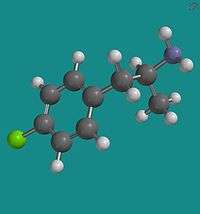''para''-Chloroamphetamine
 | |
 | |
| Identifiers | |
|---|---|
| |
| CAS Number | |
| PubChem CID | |
| IUPHAR/BPS | |
| ChemSpider | |
| ChEMBL | |
| Chemical and physical data | |
| Formula | C9H12ClN |
| Molar mass | 169.651 g/mol |
| 3D model (JSmol) | |
| |
| |
| | |
para-Chloroamphetamine (PCA), also known as 4-chloroamphetamine (4-CA), is a substituted amphetamine and monoamine releaser similar to MDMA, but with substantially higher neurotoxicity, thought to be due to the unrestrained release of both serotonin and dopamine by a metabolite.[1] It is used as a neurotoxin by neurobiologists to selectively kill serotonergic neurons for research purposes, in the same way that 6-hydroxydopamine is used to kill dopaminergic neurons.[2][3][4][5]
However, the effects of the compound on experimental animals appear less encouraging.[6] It has been detected as an apparent designer drug,[7] along with the related 3-chloroamphetamine, which is even more potent as a releaser of dopamine and serotonin but slightly less neurotoxic.[8][9][10][11][12]
The closely related N-methylated derivative, para-Chloromethamphetamine (CMA), which is metabolised to para-chloroamphetamine in vivo, has neurotoxic properties as well.
Legal Status
China
As of October 2015 4-CA is a controlled substance in China.[13]
See also
- para-Chloromethamphetamine
- Substituted amphetamines
- 3,4-Dichloroamphetamine (DCA)
- 4-Fluoroamphetamine (4-FA)
- 4-Methylamphetamine (4-MA)
- 5,7-Dihydroxytryptamine (5,7-DHT)
- para-Bromoamphetamine (PBA)
- para-Chlorophenylalanine (PCPA)
- para-Iodoamphetamine (PIA)
- 6-CAT
References
- ↑ Miller, K. J.; Anderholm, D. C.; Ames, M. M. (1986). "Metabolic activation of the serotonergic neurotoxin para-chloroamphetamine to chemically reactive intermediates by hepatic and brain microsomal preparations". Biochemical Pharmacology. 35 (10): 1737–1742. PMID 3707603. doi:10.1016/0006-2952(86)90332-1.
- ↑ Gal, E. M.; Cristiansen, P. A.; Yunger, L. M. (1975). "Effect of p-chloroamphetamine on cerebral tryptophan-5-hydroxylase in vivo: A reexamination". Neuropharmacology. 14 (1): 31–9. PMID 125387. doi:10.1016/0028-3908(75)90063-5.
- ↑ Curzon, G; Fernando, J. C.; Marsden, C. A. (1978). "5-Hydroxytryptamine: The effects of impaired synthesis on its metabolism and release in rat". British Journal of Pharmacology. 63 (4): 627–34. PMC 1668117
 . PMID 80243. doi:10.1111/j.1476-5381.1978.tb17275.x.
. PMID 80243. doi:10.1111/j.1476-5381.1978.tb17275.x. - ↑ Colado, M. I.; Murray, T. K.; Green, A. R. (1993). "5-HT loss in rat brain following 3,4-methylenedioxymethamphetamine (MDMA), p-chloroamphetamine and fenfluramine administration and effects of chlormethiazole and dizocilpine". British Journal of Pharmacology. 108 (3): 583–9. PMC 1908028
 . PMID 7682129. doi:10.1111/j.1476-5381.1993.tb12846.x.
. PMID 7682129. doi:10.1111/j.1476-5381.1993.tb12846.x. - ↑ Freo, U; Pietrini, P; Pizzolato, G; Furey, M; Merico, A; Ruggero, S; Dam, M; Battistin, L (1995). "Cerebral metabolic responses to clomipramine are greatly reduced following pretreatment with the specific serotonin neurotoxin para-chloroamphetamine (PCA). A 2-deoxyglucose study in rats". Neuropsychopharmacology. 13 (3): 215–22. PMID 8602894. doi:10.1016/0893-133X(95)00053-G.
- ↑ Alexander T. Shulgin (1978). Leslie L. Iversen; Susan D. Iversen; Solomon H. Snyder, eds. Handbook of Psychopharmacology. 11: Stimulants. New York: Plenum Press.
- ↑ Lin TC, Lin DL, Lua AC (2011). "Detection of p-chloroamphetamine in urine samples with mass spectrometry". Journal of Analytical Toxicology. 35 (4): 205–210. PMID 21513613. doi:10.1093/anatox/35.4.205.
- ↑ Fuller, R.; Schaffer, R. J.; Roush, B. W.; Molloy, B. B. (1972). "Drug disposition as a factor in the lowering of brain serotonin by chloroamphetamines in the rat". Biochemical Pharmacology. 21 (10): 1413–1417. PMID 5029422. doi:10.1016/0006-2952(72)90365-6.
- ↑ Ögren, S. O.; Ross, S. B. (2009). "Substituted Amphetamine Derivatives. II. Behavioural Effects in Mice Related to Monoaminergic Neurones". Acta Pharmacologica et Toxicologica. 41 (4): 353–368. PMID 303437. doi:10.1111/j.1600-0773.1977.tb02674.x.
- ↑ Ross, S. B.; Kelder, D. (2009). "Inhibition of 3H-Dopamine Accumulation in Reserpinized and Normal Rat Striatum". Acta Pharmacologica et Toxicologica. 44 (5): 329–335. PMID 474143. doi:10.1111/j.1600-0773.1979.tb02339.x.
- ↑ Fuller, R. W.; Baker, J. C. (1974). "Long-lasting reduction of brain 5-hydroxytryptamine concentration by 3-chloroamphetamine and 4-chloroamphetamine in iprindole-treated rats". Journal of Pharmacy and Pharmacology. 26 (11): 912–914. PMID 4156568. doi:10.1111/j.2042-7158.1974.tb09206.x.
- ↑ Ross, S. B.; Ögren, S. O.; Renyi, A. L. (2009). "Substituted Amphetamine Derivatives. I. Effect on Uptake and Release of Biogenic Monoamines and on Monoamine Oxidase in the Mouse Brain". Acta Pharmacologica et Toxicologica. 41 (4): 337–352. PMID 579062. doi:10.1111/j.1600-0773.1977.tb02673.x.
- ↑ "关于印发《非药用类麻醉药品和精神药品列管办法》的通知" (in Chinese). China Food and Drug Administration. 27 September 2015. Retrieved 1 October 2015.